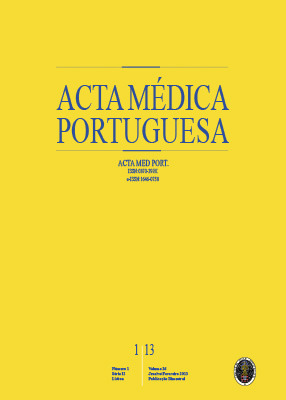Lesões Decorrentes do Posicionamento para Cirurgia: Incidência e Fatores de Risco
DOI:
https://doi.org/10.20344/amp.4006Resumo
Introdução: O posicionamento cirúrgico adequado é um passo essencial que é muitas vezes subestimado, no entanto há que considerar que pode levar a lesões graves, mas evitáveis. O objetivo deste estudo é avaliar a incidência de lesão decorrente do posicionamento cirúrgico, bem como tentar identificar os seus fatores de risco. Material e Métodos: Estudo prospetivo que decorreu durante um ano e incluiu doentes de diferentes especialidades cirúrgicas propostos para cirurgia eletiva. Os doentes foram avaliados previamente à intervenção cirúrgica, sendo considerados critérios de exclusão: idade menos de 18 anos, classificação da American Society of Anesthesiologists ASA > III, neuropatia ou doenças neuromusculares documentadas. Consideraram-se lesões decorrentes do posicionamento: eritema não reversível sob digitopressão e/ou persistente > 30 minutos; dor severa em pontos de pressão e não relacionada com o local cirúrgico (Escala analógica visual - VAS ≥ 7) e lesão de nervo periférico. Avaliaram-se as variáveis: sexo, idade, Índice Massa Corporal, classificação ASA, técnica anestésica, tipo de posicionamento, duração da cirurgia e a sua relação com o aparecimento de lesão pós-operatória. Resultados: Dos 172 doentes incluídos no estudo, foram identificadas lesões perioperatórias em 12,2%, sendo que cinco destes doentes apresentaram mais do que uma lesão (dor em ponto de pressão + neuropatia). Destes, 9,9% queixou-se de dor severa (Escala analógica visual - VAS ≥ 7) em pontos de pressão, 4,7% apresentou neuropatia periférica e 0,6% apresentou eritema que não cedia à digitopressão. No grupo que desenvolveu lesão, não houve diferença significativa no que diz respeito à idade, sexo, técnica anestésica, duração da cirurgia e posicionamento. No que diz respeito à classificação ASA, verificou-se que os doentes ASA II e III apresentaram uma maior incidência de lesão (90,5%) quando comparados com os doentes ASA I (9,5%), p < 0,05. O Índice Massa Corporal > 30 Kg / m2 mostrou também estar associado ao desenvolvimento de lesão perioperatória, p < 0,001. Na análise isolada de lesão neuropática constatou-se que o Índice de Massa Corporal > 30 Kg / m2 estava relacionado com a ocorrência de neuropatia, p < 0,05. No que se refere às restantes variáveis e sua relação com neuropatia pós-operatória, não se verificou uma relação estatisticamente significativa. Conclusão: A evidência científica para a prevenção das lesões no peri operatório, nomeadamente das neuropatias, é limitada. A avaliação pós-operatória dos doentes é também essencial pois permite o reconhecimento precoce das lesões e a sua documentação e orientação.
Downloads
Downloads
Publicado
Como Citar
Edição
Secção
Licença
Todos os artigos publicados na AMP são de acesso aberto e cumprem os requisitos das agências de financiamento ou instituições académicas. Relativamente à utilização por terceiros a AMP rege-se pelos termos da licença Creative Commons ‘Atribuição – Uso Não-Comercial – (CC-BY-NC)’.
É da responsabilidade do autor obter permissão para reproduzir figuras, tabelas, etc., de outras publicações. Após a aceitação de um artigo, os autores serão convidados a preencher uma “Declaração de Responsabilidade Autoral e Partilha de Direitos de Autor “(http://www.actamedicaportuguesa.com/info/AMP-NormasPublicacao.pdf) e a “Declaração de Potenciais Conflitos de Interesse” (http://www.icmje.org/conflicts-of-interest) do ICMJE. Será enviado um e-mail ao autor correspondente, confirmando a receção do manuscrito.
Após a publicação, os autores ficam autorizados a disponibilizar os seus artigos em repositórios das suas instituições de origem, desde que mencionem sempre onde foram publicados e de acordo com a licença Creative Commons









